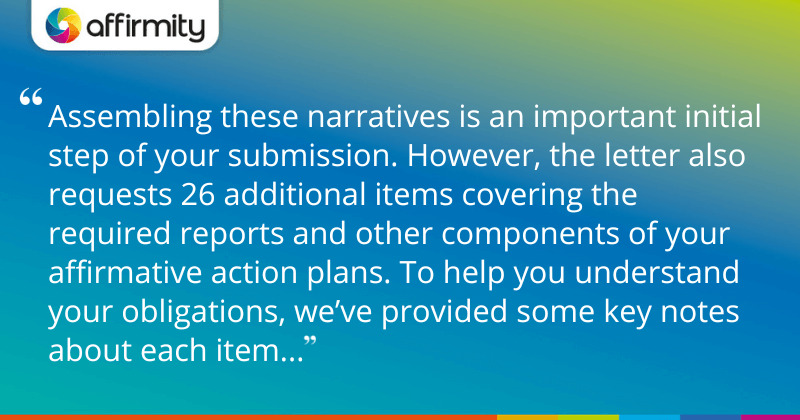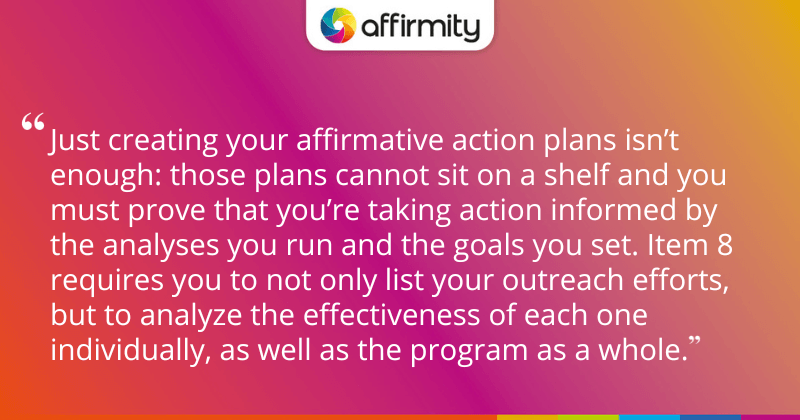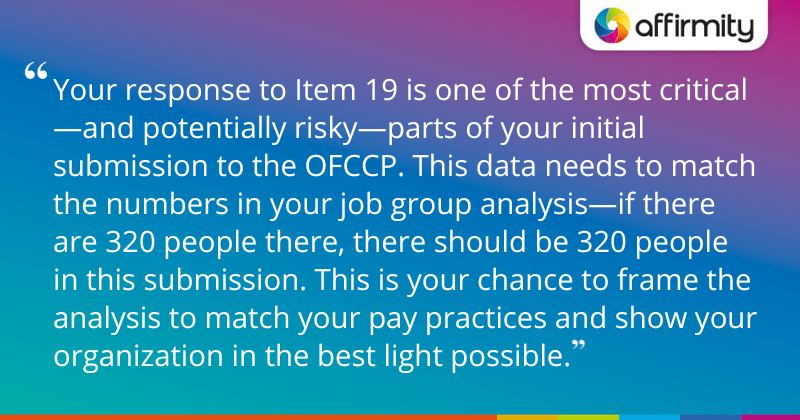Whether you’re a federal contractor with affirmative action responsibilities and an imminent audit, or just curious about what the OFCCP’s auditing process looks like, you may have heard of the “26 items” you’ll be required to submit (or until August 2023, the “22 items”). In this in-depth article, Affirmity’s Manager of Consulting Services, Brad Wiltshire, examines each of the items, describes their purpose, and provides valuable tips that’ll help you steer your audit response in the right direction.
A Run-Down of All 26 Items on the OFCCP’s Affirmative Action Compliance Review Scheduling Letter

Once selected for audit, your organization will receive an audit scheduling letter. This letter will include all of the legal background for the process, the timeline that you and the OFCCP will be working to, and a request for your three AAP narratives. You should, of course, have one narrative each for:
- Females and minorities
- Individuals with disabilities
- Protected veterans
Assembling these narratives is an important initial step of your submission. However, the letter also requests 26 additional items covering the required reports and other components of your affirmative action plans. To help you understand your obligations, we’ve provided some key notes about each item below.
Items 1 Through 7: Your Core AAP Statistical Reports
The first seven items can be characterized as your core AAP reports, a series of analyses that you should be preparing annually as part of your affirmative action program. Affirmity can easily pull each of these items for its services clients, and it will start compiling these reports on their behalf as soon as receipt of the scheduling letter has been discussed.
- “An organizational display or workforce analysis prepared according to 41 CFR § 60-2.11.”
This item is your Workforce Analysis, providing a per-department view of your job titles, listed with salary codes or ranges. We recommend ensuring that each department has at least one managerial job title listed, or an explanation that there’s no manager in a given department if that’s the structure. You should additionally have a separate report for included and excluded employees (e.g. if individuals report elsewhere).
- “The formation of job groups (covering all jobs) consistent with criteria given in 41 CFR § 60-2.12.”
- “For each job group, a statement of the percentage of minority and female incumbents as described in 41 CFR § 60-2.13.”
Items 2 and 3 are covered by your Job Group Analysis. Well ahead of time, you’ll have created this list of all your job groups and the job titles within them, and this will include the current percentages of minority and female incumbents in those roles.
- “For each job group, a determination of minority and female availability pursuant to 41 CFR § 60-2.14.”
- “For each job group, the comparison of incumbency to availability as explained in 41 CFR §60-2.15.).”
These items are covered in an Incumbency vs. Availability report. This report gets into the detail of who currently works for you, and who’s available to work for you in terms of internal and external availabilities (e.g. census data).
- “Placement Goals for each group in which the percentage of minorities or women employed is less than would be reasonably expected given their availability as described in 41 CFR § 60-2.16.”
In the event that your Incumbency vs. Availability report reveals shortfalls of females or minorities, you’ll have to additionally provide item 6, a Placement Goals report detailing goals set for the current plan year.
- “Pursuant to 41 CFR § 60-2.17(c), provide documentation demonstrating the development and execution of action-oriented programs designed to correct any problem areas identified pursuant to 41 CFR § 60-2.17(b). The documentation should cover action-oriented programs addressing problem areas identified for the immediately preceding AAP year.”
This item was newly added in August 2023 and requires contractors to provide documentation proving that they are actively implementing action-orientated programs in furtherance of any placement goals or other problem areas uncovered in their AAP. This information was previously sought only in follow-up requests where warranted.
FURTHER AUDIT PREPARATION INSIGHTS | ‘How to Prepare Your Employees for On-Site Visits From OFCCP Auditors’
Items 8 Through 11: Section 503 (Rehabilitation Act of 1973)

The next four items are those relevant to your obligations under Section 503 of the Rehabilitation Act of 1973—your plans with regard to people with disabilities.
- “Documentation of appropriate outreach and positive recruitment activities reasonably designed to effectively recruit qualified individuals with disabilities, and an assessment of the effectiveness of these efforts as provided in 41 CFR § 60-741.44(f). This includes documentation of all activities undertaken to comply with the obligations at 41 CFR § 60-741.44(f), the criteria used to evaluate the effectiveness of each effort, and whether you found each effort to be effective. The documentation should also indicate whether you believe the totality of your efforts were effective. In the event the totality of your efforts were not effective in identifying and recruiting qualified individuals with disabilities, provide detailed documentation describing your actions in implementing and identifying alternative efforts, as provided in 41 CFR § 60-741.44(f)(3).”
Just creating your affirmative action plans isn’t enough: those plans cannot sit on a shelf and you must prove that you’re taking action informed by the analyses you run and the goals you set. Item 8 requires you to not only list your outreach efforts, but to analyze the effectiveness of each one individually, as well as the program as a whole. For example, you must list the job fairs you’ve attended and the organizations you’ve contacted, but also include detailed results showing how these actions made a difference, and what you’ll do to improve areas where ineffective.
The wording of this item was revised significantly in August 2023 to double down on this emphasis on documenting and evolving outreach and positive recruitment activities, and prompts a more detailed evaluation of their effectiveness. When efforts are found to be ineffective, the contractor must also provide detailed documentation describing the alternative efforts that were implemented.
- “Documentation of all actions taken to comply with audit and reporting system requirements.”
For item 9, you need to provide evidence that you’ve conducted a self-audit examining whether you actioned your plans, looked at pay data, and whether advertising for positions, application processes, job assignments, and other processes were checked for compliance. For each of these items, you should be recording dates and any related corrective actions on an ongoing basis. As with any item, this is obviously difficult if done retrospectively—so it’s important to start recording this kind of information as it’s done, rather than trying to piece it together in response to an audit.
- “Documentation of computations or comparisons described in 41 CFR 60-741.44(k) for preceding AAP year and if 6 months or more into your current AAP year, information for at least the first 6 months of the current AAP year.”
Item 10 is the data collection report. This is a listing of how many positions you had open or filled during the review period, which is typically 12 months, sometimes 18, depending on where you are in the plan year. This must include the number of hires, total number of applicants, and the population of people who self-identified as disabled in both of those groups. In some circumstances, the OFCCP may request this report for the last three years.
- “The utilization analysis evaluating the representation of individuals with disabilities in each job group, or, if appropriate, evaluating the representation of individuals with disabilities in the workforce as a whole, as provided in 41 CFR § 60-741.45. If any underutilization of individuals with disabilities is identified, provide a description of the steps taken to determine whether and where impediments for equal employment opportunity exist in accordance with 41 CFR § 60-741.45(e). Pursuant to 41 CFR § 60-741.45(e) and (f), this description shall include your assessment of personnel processes, the effectiveness of your outreach and recruitment efforts (if different than Item 8), the results of your affirmative action program audit, any other areas that might affect the success of the affirmative action program, and a description of action-oriented programs developed and executed to correct any identified problem areas. Provide this information for the immediately preceding AAP year. If you are six months or more into your current AAP year on the date you receive this listing, provide the information that reflects your progress for at least the first six months of the current AAP year.”
Contractors are required to set a goal of 7% representation for all job groups, in each plan. This can be demonstrated in a utilization analysis. As suggested above, the OFCCP requests a view of current-year progress in addition to previous-year results if your scheduling letter is received in the back half of your plan year.
This item was also revised in August 2023 to require greater depth from contractors. In addition to performing a utilization analysis, it now requires a description of all steps taken to determine whether any barriers to equal employment opportunities exist in areas where underutilization has been identified.
MORE FROM THE BLOG | ‘6 Disability-Inclusive Best Practices for Your Recruitment Process’
Items 12 Through 15: VEVRAA
Items 12 through 14 cover essentially the same ground as items 8 through 10, though the focus is instead on veterans as per contractor’s VEVRAA obligations.
- “Documentation of appropriate outreach and positive recruitment activities reasonably designed to effectively recruit qualified protected veterans, and an assessment of the effectiveness of these efforts as provided in 41 CFR § 60-300.44(f). This includes documentation of all activities undertaken to comply with the obligations at 41 CFR § 60-300.44(f), the criteria used to evaluate the effectiveness of each effort, and whether you found each effort to be effective. The documentation should also indicate whether you believe the totality of your efforts were effective. In the event the totality of your efforts were not effective in identifying and recruiting qualified protected veterans, provide detailed documentation describing your actions in implementing and identifying alternative efforts, as provided in 41 CFR § 60-300.44(f)(3).”
- “Documentation of all actions taken to comply with audit and reporting system requirements described in 41 CFR § 60-300.44(h).”
- “Documentation of the computations or comparisons described in 41 CFR 60-300.44(k) for the immediately preceding AAP year. If 6 months or more into your current AAP year, information for at least the first 6 months of the current AAP year.”
Because of these similarities, some organizations will opt to provide the items here alongside their disability reporting. Note that so long as the auditor is notified that this has been done, this is an acceptable way to submit the requested information.
Item 12 received a similar overhaul to Item 8 in the scheduling letter’s August 2023 update. Again, the extra depth provides even greater emphasis on documenting and evolving outreach and positive recruitment activities, a detailed evaluation of their effectiveness, and a description of the alternative efforts implemented when activities are found to be ineffective.
- “Documentation of hiring benchmark adopted, the methodology used to establish it if using the five factors described in 41 CFR § 60-300.45(b)(2). If you are six months or more into your current AAP year on the date you receive this listing, please also submit current year hiring data to measure against your benchmark.”
Item 15 asks for documentation of the hiring benchmark your company has adopted, whether the Department of Labor’s own benchmark (currently 5.4% effective 3/31/2023) or a custom benchmark developed using the appropriate factors. If more than six months into the plan year, you must also provide a report showing your veteran hiring rate compared to the chosen benchmark during that timeframe.
DIVE DEEPER INTO AAP DATA | ‘4 Signs That Your Applicant Data Won’t Pass an OFCCP Audit’
Items 16 Through 26: Other Useful Context and In-Depth Analyses

The remaining requests help auditors gain a fine-detail understanding of your AAPs, alongside information from your organization’s other obligations such as EEO-1 data collection, its policies, and other information that provides useful context about your operations.
- “Copies of EEO-1 for the last three years.”
Submit the EEO-1 reports covering the establishment under audit for the last three years. Affirmity recommends that you download certified copies directly from the EEO-1 website for submission (though it’s critical that organizations keep their own copies in case this avenue isn’t available).
- “Copy of Collective Bargaining Agreements. Include other documents such as policy statements, employee notices or handbooks, etc. that implement, explain, or elaborate on provisions of Collective Bargaining Agreements.”
Because collective bargaining agreements (CBAs) have implications for how hiring is conducted and controlled, organizations with union contracts should provide copies of any CBAs at any facilities subject to audit.
- “Data on employment activity for immediately preceding AAP year and, if 6 months or more into your current AAP year, information for at least the first six months of the current AAP year. Information can be presented by job group or job title.
- Applicants: For each job group or job title, the total number of applicants identified by gender and by race/ethnicity. For each job group or job title, applicants for whom race and/or gender is not known should be included in the data submitted.
- Hires: For each job group or job title, this analysis must consist of the total number of hires identified by gender and race/ethnicity.
- Promotions: For each job group or job title, provide the total number of promotions by gender and race/ethnicity. Include a definition of “promotion” as used by your company.
- Terminations: For each job group or job title, provide the total number of employee terminations by gender and race/ethnicity.
- For each job title or job group, provide the total number of employees, by gender and race/ethnicity, as of the start of the immediately preceding AAP year.”
As perhaps betrayed by the extra detail provided, Item 18 is an area of greater focus for auditors—mistakes in this area can be problematic. It requires you to submit counts of applicants, hires, promotions, and terminations by gender and race for each job group or job title. Note that OFCCP now requests that you define how the term “promotions” is used by your organization, so be sure whatever explanation you provide matches how promotions are determined in practice.
- “Employee level compensation data for all employees (including but not limited to full-time, part-time, contract, per diem or day labor, and temporary employees) as of (1) the date of the organizational display or workforce analysis and (2) as of the date of the prior year’s organizational display or workforce analysis. Provide gender and race/ethnicity information and hire date for each employee as well as job title, EEO-1 Category, and job group in a single file.
- For all employees, compensation includes base salary and or wage rate, and hours worked in a typical work week. Other compensation or adjustments to salary such as bonuses, incentives, commissions, merit increases, locality pay, or overtime should be identified separately for each employee.
- Contractor may provide any additional data on factors used to determine employee compensation (education, past experience, duty location, performance ratings, department or function, salary level/band/range/grade).
- Documentation and policies related to compensation practices should be included in the submission.”
Your response to Item 19 is one of the most critical—and potentially risky—parts of your initial submission to the OFCCP. This data needs to match the numbers in your job group analysis—if there are 320 people there, there should be 320 people in this submission. You should cover everyone on your payroll as of your plan date, and the records should contain:
- Gender
- Race
- EEO category
- Job group
- Job title
- A unique identifier (names aren’t required, employee IDs may be the best option)
- The requested components of each employee’s compensation
In addition to base salary, wages, and/or hours, you should be providing other forms of compensation such as bonuses, incentives, commissions, and so on, as applicable.
One big takeaway about this item is that if you just provide the raw data without offering any explanations of your criteria for how people are compensated and how your salary bands work, the OFCCP will run its own analysis, likely based on job group alone, and may find possible pay issues as a result. Therefore, submit documentation on your policies, or failing that, a detailed explanation that can help steer them toward your valid rationales. This is your chance to frame the analysis to match your pay practices and show your organization in the best light possible.
In August 2023, the OFCCP added a small amount of text to Item 19 with big implications: it now requests everything above for the prior plan year as well as the current plan year. It is likely that contractors who’ve not been conducting the required analysis annually will be caught off guard by this new requirement—so make sure you’re performing and documenting compensation analyses on an annual basis!
- “Information on EO 11246 affirmative action goals for immediately preceding AAP year and progress on goals for the current AAP year. This report must include information that reflects:
- job group representation at the start of the AAP year (i.e., total incumbents, total minority incumbents, and total female incumbents);
- the placement goals established for minorities and women at the start of the AAP year; and
- the actual number of placements (hires plus promotions) made during the AAP year into each job group with goals (i.e., total placements, total minority placements, and total female placements). For all placement goals not attained, describe the specific good faith efforts made to remove identified barriers, expand equal employment opportunity, and produce measurable results.
If 6 months or more into your current AAP year, submit information that reflects progress on goals established in the current AAP year and describe implementation of action-oriented programs designed to achieve these goals.”
Item 20 is covered in part by your Goal Attainment report (if applicable), a standard report provided by Affirmity. This report shows how successful you were in achieving the previous year’s goals, and the OFCCP may want to see documentation of all efforts intended to meet those goals if any are not met.
- “Identify and provide information and documentation of policies, practices, or systems used to recruit, screen, and hire, including the use of artificial intelligence, algorithms, automated systems or other technology-based selection procedures.”
There has been a growing trend towards the use of HR software marketed as incorporating automation, artificial intelligence, and other technology-based selection processes in recent years. Considering that such technologies have the potential to both mitigate and exacerbate biases, the OFCCP now (as of August 2023) requires contractors to disclose use of this technology while seeking a full understanding of the processes of its contractors.
- “Documentation that the contractor has satisfied its obligation to evaluate its “compensation system(s) to determine whether there are gender-, race-, or ethnicity-based disparities,” as part of the contractor’s “in-depth analyses of its total employment process” required by 41 CFR 60-2.17(b)(3). Include documentation that demonstrates at least the following:
- When the compensation analysis was completed;
- The number of employees the compensation analysis included and the number and categories of employees the compensation analysis excluded;
- Which forms of compensation were analyzed and, where applicable, how the different forms of compensation were separated or combined for analysis (e.g., base pay alone, base pay combined with bonuses, etc.);
- That compensation was analyzed by gender, race, and ethnicity; and
- The method of analysis employed by the contractor (e.g., multiple regression analysis, decomposition regression analysis, meta-analytic tests of z-scores, compa-ratio regression analysis, rank-sums tests, career-stall analysis, average pay ratio, cohort analysis, etc.).”
Contractors have the option of preparing separate privileged in-depth compensation analyses (ideally with advice from legal), but they must provide the details above so the OFCCP understands the basis for the compensation decisions made. Contractors must still provide a separate compensation analysis to the OFCCP that satisfies the conditions of the other items of the combined scheduling letter and itemized listing. Affirmity can also prepare any of these in-depth analyses for you.
- “Copies of reasonable accommodation policies, and documentation of any accommodation requests received and their resolution, if any.”
This item is fairly self-explanatory. Though you aren’t required to have a written explanation of your reasonable accommodation policies, it’s best practice to have one. Be sure to keep track of accommodation requests and results, and be prepared to submit the records.
- “Copies of equal employment opportunity (EEO) policies, including antiharassment policies, policies on EEO complaint procedures, and policies on employment agreements that impact employees’ equal opportunity rights and complaint processes (e.g., policies on arbitration agreements). Please provide this information for policies in place for the immediately preceding AAP year. If you are six months or more into your current AAP year when you receive this listing, provide this information for at least the first six months of the current AAP year.”
The final new addition made in August 2023, Item 24 requests copies of a number of workplace policies and employment agreements that impact employee equal opportunity rights and complaint procedures.
- “Your most recent assessment of your personnel processes, as required by 41 CFR §§ 60-300.44(b) and 60-741.44(b), including a description of the assessment and any actions taken or changes made as a result of the assessment.”
Reminiscent of items 9 and 13, you should be documenting your self-audit activity with regard to your personnel processes, seeing whether they impact veteran or disabled hiring, promotion, or compensation.
- “Your most recent assessment of physical and mental qualifications, as required by 41 CFR §§ 60-300.44(c) and 60-741.44(c), including the schedule of the assessment and any actions taken or changes made as a result of the assessment.”
The final item requires you to produce evidence that you are reassessing your job descriptions and removing any restrictions based on the current realities of taking on the role. For example, a heavy lifting requirement may no longer apply because of a change in the items you handle, or the machinery available on your premises. Note that your review of these positions needs to be more detailed and methodical than simply “it’s considered every time we post a position.”
Conclusion—And Are There Potential Changes Ahead?
Hopefully, this extended look at the 26 items of the scheduling letter has helped to make your job easier. The changes made in August 2023 came after several months of consultation and earlier drafts, but there’s always the possibility that there may be further adjustments made in the years ahead. If and when these proposed changes are made, we’ll be sure to update this article to reflect the new requirements—so be sure to bookmark this page if you find it useful!
We can help you ensure your data is audit-ready—and take your data collection practice beyond simple compliance. Contact us to find out more.
This article was originally published in June 2023 and updated in October 2023 to reflect changes to the Combined Scheduling Letter and Itemized Listing made in late August 2023.
About the Author
 Brad Wiltshire is a Manager of Consulting Services at Affirmity. He has 15 years of experience developing Affirmative Action Plans as well as EEO-1, and VETS reports for clients across many industries. A former attorney, Mr. Wiltshire’s legal background has helped him provide ongoing guidance and support for OFCCP audits and other compliance needs. Connect with him on LinkedIn.
Brad Wiltshire is a Manager of Consulting Services at Affirmity. He has 15 years of experience developing Affirmative Action Plans as well as EEO-1, and VETS reports for clients across many industries. A former attorney, Mr. Wiltshire’s legal background has helped him provide ongoing guidance and support for OFCCP audits and other compliance needs. Connect with him on LinkedIn.
